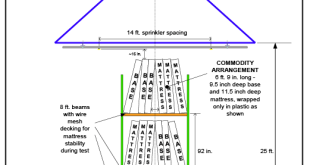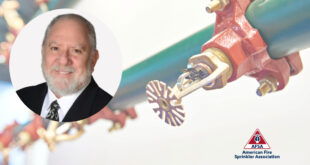
PRESIDENT’S REPORT
Why are standards, not standard? I mean the very word itself conjures up thoughts of other words, like normal, typical, common, habitual, or familiar. However, it seems obvious to those of us in the fire sprinkler world that standards, as in NFPA standards, are not applied, enforced, or accepted in any typical or common way. This is especially true when we compare plan review or field acceptance testing to the hundreds of thousands of systems our industry calls for inspections every day! Where am I going with this, you might ask? We here at AFSA receive dozens of requests for Technical Reviews every day, often from the same two entities arguing over the same section of a code or standard on the same project.
Now, don’t get me wrong, the AFSA Technical Services Department is happy to assist in any way possible, and we don’t judge. In fact, this kind of activity is largely why we’re here. I assure you that we love this part of the job because it helps us understand what part of the codes and standards need work to make the language and the intent clearer for all users.
Water-based fire protection systems are designed to codes, standards, and project specifications, usually NFPA standards which are read and applied by layout technicians and reviewed by plans examiners. While all stakeholders are reading from the same rule books, things seem to get a little out of whack when two people read the same document with differing interests in mind. This is even more the case when money is involved! In 1992, when Rodney King asked something to the effect of,“Can we just all get along?” I remember thinking to myself, he must not be a fire sprinkler layout technician, fitter, or work in the fire prevention bureau! But wait, aren’t we all reading and applying the same codes and standards? Singing from the same hymnal? Focused on fire prevention and life safety? Of course we are.
Like most problems, solutions are the result of communication, and good communication usually doesn’t start until after the frustration passes and we start to think about reasonable and viable solutions that can fit everyone’s narratives and objectives. In our industry, the objectives can vary, making it difficult to get buy-in and please all stakeholders, so let’s look at the players, their roles, and their objectives in a construction project:
First, we have the owner, perhaps a lender or lending institution, architects, engineers, a general contractor, subcontractors, including a fire sprinkler contractor, materials suppliers, a fabricator, municipal plans reviewers, and municipal field inspectors, not to mention a possible engineer of record or sprinkler layout technician, and installers, all of whom want to make money in the process of delivering or reviewing the project. NFPA 13 says the system design method gets selected by the designer of the system, but the Authority Having Jurisdiction (AHJ) must approve the selection… checks and balances. That sounds like the great system of governance we learned about in 5th grade social studies class. By the way, the municipal authority isn’t the only one who is considered the AHJ, but their department is the primary first responder when something bad happens. As such, they get to decide what is appropriate for their jurisdiction. The municipal plan reviewer has the purview to ask for anything he/she wants, though we assume they will enforce their adopted codes and standards in a uniform way.
I have the privilege of presenting seminars for multiple organizations on a variety of related topics but the issue where I find the most controversy continues to be in plan review. I think this is because we try to communicate through digital or print means, as opposed to getting together and having a discussion to share the information, decisions, and desired outcomes. Think about how many back-and-forth email messages we send and receive before we just pick up the phone and have a conversation… problem solved. I think we should apply that same solution to the plan review process, where things are complicated and can be more easily explained in person.
Regardless of the conflict, on or off the job, communication is the key to resolution. To be effective, communication has to be timely and hopefully polite, considerate, and early enough in the timeline of a problem to save everyone’s pride, ego, and money. For most of us in construction, that means asking questions before we install something that might be controversial. Asking questions and getting agreement early in the process allows projects to go better because we solved the conflict before it became one. Making decisions in a democratic way, with other stakeholders allows us to implement those decisions as a dictator, since we all agreed up front. Trying to find solutions and resolve issues after systems or components are installed, after plans have been reviewed and accepted or approved, is neither cost-effective nor fair to the owner of a building or business.
The world of commerce, like technology itself, has changed a lot in the past 10 or more years, and the rate of change continues to accelerate. The reality for contractors and AHJs alike is that we need to work together to ensure the built environment is safe for occupants, while allowing commerce to prosper in our communities. Allowing healthy businesses to grow and contribute to the financial health of our towns, cities, and states by contributing tax dollars for municipal programs, police and fire salaries, etc.
We are all in this together for the common good, for fire and life safety and for the prospering communities we live in. This thing of ours, the wonderful and amazing business of fire protection, is something we can and should all be proud to be a part of—and yes, we can all get along, united by a common cause and guided by the codes and standards we design to, build to, and enforce.
ABOUT THE AUTHOR:

Bob Caputo, CFPS, is president of AFSA. He has been an important part of the fire sprinkler industry for over 41 years and is a long-time member of AFSA and promoter of merit shop contracting. He has chaired and served on many NFPA committees. Caputo has written and presented seminars throughout the world on fire protection and life-safety systems and is a regular speaker at AFSA and NFPA conventions. He has developed AFSA education and training materials, and chaired two chapters of AFSA—Arizona and Southern California. Caputo is the recipient of numerous awards, including Fire Protection Contractor magazine’s “Industry person of the Year,” San Diego County Fire Chief’s Association’s “Fire Prevention Officer of the Year,” and AFSA’s highest honor, the Henry S. Parmelee Award.

 Sprinkler Age A Publication of the American Fire Sprinkler Association
Sprinkler Age A Publication of the American Fire Sprinkler Association



